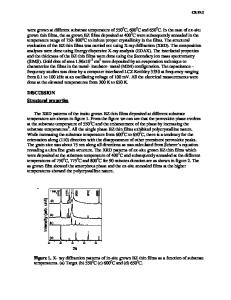In situ growth of fatigue-free SrBi2Ta2O9 films by pulsed laser ablation
- PDF / 437,015 Bytes
- 7 Pages / 612 x 792 pts (letter) Page_size
- 39 Downloads / 388 Views
MATERIALS RESEARCH
Welcome
Comments
Help
In situ growth of fatigue-free SrBi2 Ta2 O9 films by pulsed laser ablation Hung-Ming Yang, Jian-Shing Luo, and Wen-Tai Lin Department of Materials Science and Engineering, National Cheng Kung University, Tainan 70101, Taiwan, Republic of China (Received 10 August 1996; accepted 17 September 1996)
In situ growth of SrBi2 Ta2 O9 (SBT) films as a function of Bi concentration in the target, substrate temperature, oxygen pressure, and the thickness of bottom Pt electrode by pulsed laser deposition was studied. The SBT phase initially formed at a temperature of 500 –520 ±C. The SBT films grown from the stoichiometric target generally showed Bi deficiency. A well-crystallized and stoichiometric SBT film could be grown at a temperature of 550–580 ±C in 300 mTorr of O2 from the surplus Bi targets, which showed c-axis preferred orientation. The formation temperature of SrTa4 O11 (ST) phase was above 600 ±C, depending on the Bi concentration in the target. Higher oxygen pressure raised the formation temperatures of the SBT and ST phases and concomitantly ˚ enriched the Bi concentration of the SBT films. For the bottom Pt electrode 1200 A thick, the voids were not observed in the SBT overlayer until the deposition temperatures were above 590 ±C. Annealing at temperatures above 700 ±C in an atmosphere of O2 was required to improve the contact between Pt electrode and the SBT film and hence the ferroelectric properties of the SBT film. In the present study, a smooth, stoichiometric, and c-axis oriented SBT film, about 350 nm thick, could be grown on Pt ± ˚ (1200 A)yTiySiO 2ySi at a temperature of 550–580 C in 300 mTorr of O2 from the Bi surplus targets, which showed remnant polarization (Pr ) of 3.0–3.5 mCycm2 and coercive field (Ec ) of 30–40 kV/cm at 4 V. No fatigue was observed up to 109 switching cycles.
I. INTRODUCTION
Ferroelectric thin films have attracted much attention for application in nonvolatile memories because of their low operating voltage, fast switching speed, and better endurance.1–4 PbZrx Ti12x O3 (PZT) thin film is the most popular material under study for nonvolatile memory applications. It is well known that PZT films with Pt electrodes exhibit severe polarization fatigue during electric field cycling.5,6 Interposing the PZT film between conducting oxide electrodes such as YBa2 Cu3 O7 ,7 La0.5 Sr0.5 CoO3 ,8,9 RuO2 ,10 and SrRuO3 11 has been proven effective in eliminating the polarization fatigue of the PZT film. However, the resistivities of the oxide electrodes are generally higher than those of the metal electrodes, resulting in a higher RC time constant of the capacitor. In addition, RuO2 electrodes may lead to high leakage currents due to the formation of the second phase.10 Recently, it was reported that SrBi2 Ta2 O9 (SBT) thin films show no polarization fatigue up to about 1012 switching cycles on Pt electrode.12–22 SBT films have been grown by methods such as laser ablation,13–15 metallorganic decomposition,12,16–21 and metallorganic chemical vapor de
Data Loading...








